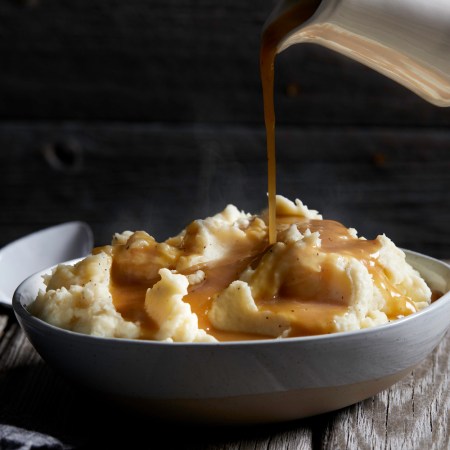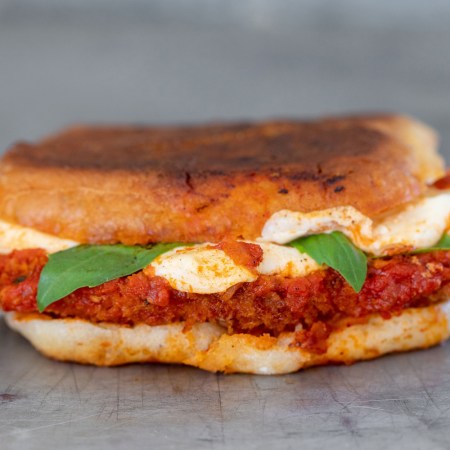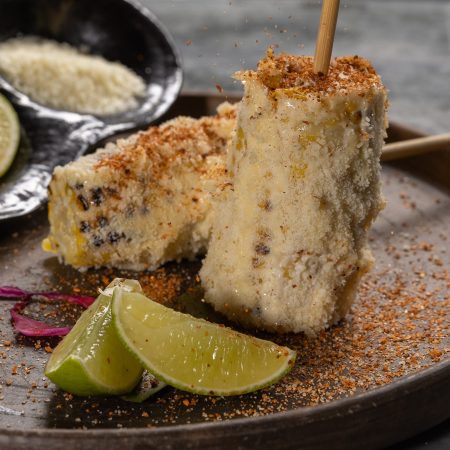As The Sugarhill Gang established in their 1979 track “Rapper’s Delight,” there’s nothing worse than going over to a friend’s house to eat and being served soggy macaroni, mushed peas and chicken that tastes like wood. The Gang had a point, as dry poultry, except in the case of chicken skins, is a major buzzkill and has ruined many a meal throughout history.
Sick of the scourge of parched birds upon society, foodie entrepreneur Dan Mezzalingua and executive chef Joe LoNigro made it their mission to create a restaurant where chicken-loving New Yorkers would never have to worry about biting into dry-as-a-bone chicken. So they opened Brine, a fast-casual Chelsea eatery that dishes up juicy, flavorful chicken that’s undergone a 36-hour brining process to add moisture and salt to the birds before they’re air chilled and roasted. The birds are then finished on the grill and topped with the eatery’s signature sauce.
Conceived of by Mezzalingua after he had the best chicken of his life during a trip to Jamaica and later found out that it had been brined, Brine uses a recipe boasting ingredients including sugar, salt, pepper, garlic and rosemary. The technique was perfected over the course of six months of testing on hundreds of pounds of chicken. Founded in 2019, Mezzalingua and LoNigro’s restaurant now serves up chicken in salads, sandwiches, bowls or on its own along with sides like grilled coleslaw, charred broccoli and white balsamic farro.
As LoNigro explains to InsideHook, the science behind brining is based on the principle of osmosis. “When meat is placed in a saltwater solution, the salt ions in the water move through the cell membrane of the meat and create a concentration gradient,” he says. “This causes the water inside the meat cells to move out of the meat and into the brine solution in order to balance the concentration of salt on both sides of the membrane. As a result, the meat absorbs water and salt. You’re basically replacing the flavorless juice within the chicken with a seasoned, extra amount of juice, all while sealing the protein as well. The essence of herbs and spices will be pulled into the meat through the osmosis process.”
Most commonly done with Thanksgiving turkeys, brining — which is different than using a marinade that’s high in vinegar or acid because it thoroughly works on the exterior as well as the interior of the protein — is just as effective with chicken. According to LoNigro, the juiciness created by the process, which calls for roughly one cup of salt per gallon of water and is optimal for brining roughly five pounds of chicken per gallon, is worth the squeeze.
A Sushi Chef’s Top-Notch Recipe for Chicken Nuggets
How to make your chicken “sing”“Brining turkey for Thanksgiving is definitely the most common because the breast meat is much larger and typically winds up dry,” LoNigro says. “It’s one day a year so people are willing to put in the effort. It’s not as common with chicken, especially with home cooks, because it requires prep and planning ahead. But the results are just non-comparable. Chicken holds brine really well and absorbs it really nicely. Even the chicken cold is better. That’s always been my gauge for pizza. Is it good cold? After the brining process, the chicken has a better mouthfeel, even cold.”
And how would LoNigro describe the mouthfeel of brined chicken versus the non-brined variety? “Right when it hits your tongue you feel the salt and the moisture,” he says. “This doesn’t sound very eloquent, but that fuzzy feeling of dry chicken almost sucking the moisture out of your mouth isn’t there. Rather than compensating for the dryness, you’re salivating because of the savoriness and the salt. With chicken that isn’t brined, your mouth starts to salivate to hydrate and to search for other flavors.”
If you’re now thinking about searching for a chicken brine recipe, LoNigro’s perfect variation is below.
Joseph LoNigro's Juicy Chicken
Prep Time: 24 hours
Cook Time: 30-40 minutes
Total Time: 24 hours, 30-40 minutes
Servings: 1 gallon of brine, 2 chickens
Ingredients
- 2 whole spatchcocked 2.75 – 3 lb. chickens (or one 5 – 6 lb. bird)
- 1 cup granulated sugar
- 1 cup kosher salt
- 1 head garlic
- 12 cups potable water
- 1 whole lemon peel
- 1 full rosemary sprig
- 1 Tbsp. cracked black peppercorns
- 6 cups ice
- Olive oil, to taste
- Salt, to taste
- Pepper, to taste
Directions
-
-
Add the water, salt, sugar, garlic, lemon peel, rosemary and black peppercorns to a large stock pot.
-
Bring the mixture to a boil over high heat. Use a wooden spoon or whisk to gently stir the mixture until the salt and sugar have fully dissolved.
-
After the mixture is fully dissolved, remove the pot from heat and add the ice. The ice is important to dilute and cool the mixture. If you can wait for the mixture to cool without using ice, substitute the 6 cups of ice with 4 cups of cold water.
-
Once the brine has fully cooled (below 40 degrees), add the chickens to the brine. Ensure the chickens are fully submerged. Store the brining chicken in the refrigerator overnight for a full 24 hours.
-
Remove the chicken from the brine and place onto your roasting rack, skin side up. We recommend pulling the chicken from the brine one hour before cooking to get rid of the chill.
-
Pat the chicken dry with paper towels to remove any exterior moisture. Drizzle the skin with olive oil and season with salt and pepper.
-
Cook the chicken at 450 degrees for approximately 30-40 minutes or until the breast meat reaches an internal temperature of 165 degrees.
-
Eat right away or, for extra crispy skin, take it to the barbecue and grill for three minutes skin side down and brush with your favorite sauce.
-
This article was featured in the InsideHook newsletter. Sign up now.























